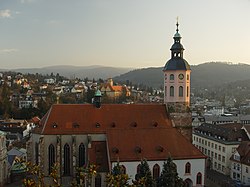Baden-Baden: Difference between revisions
m robot Adding: lmo:Baden-Baden |
m Added airport link |
||
| Line 66: | Line 66: | ||
* {{en icon}} [http://www.baden-baden.de/en/ Official site] |
* {{en icon}} [http://www.baden-baden.de/en/ Official site] |
||
*[http://www.badische-seiten.de/impressionen/index.php?action=showgallery&pfad=Hohenbaden Pictures Old Castle "Hohenbaden] |
*[http://www.badische-seiten.de/impressionen/index.php?action=showgallery&pfad=Hohenbaden Pictures Old Castle "Hohenbaden] |
||
*[http://www.airport-baden.com Baden Airport] |
|||
{{Germany_districts_baden-württemberg}} |
{{Germany_districts_baden-württemberg}} |
||
Revision as of 19:29, 3 April 2007

Baden-Baden is a town in Baden-Württemberg, Germany. It is located on the western foothills of the Black Forest, on the banks of the Oos river, in the region of Karlsruhe.
History
The springs of Baden-Baden were known to the Romans, and the foundation of the town is referred to the emperor Hadrian by an inscription of somewhat doubtful authenticity. The name of Aurelia Aquensis was given to it in honour of Aurelius Severus, in whose reign it would seem to have been well known. Fragments of its ancient sculptures are still to be seen, and in 1847 remains of Roman vapour baths, well preserved, were discovered just below the New Castle.
The town was named Baden (without the repetition) in the Middle Ages. From the 14th century down to the end of the 17th, Baden-Baden was the residence of the margraves of Baden, to whom it gave its name. They first dwelt in the Old Castle, the ruins of which still occupy the summit of a hill above the town, but in 1479, they moved to the New Castle, which is situated on the hillside nearer to the town, and is renowned for its subterranean dungeons. During the Thirty Years' War, Baden-Baden suffered severely from the various combatants, especially from the French, who pillaged it in 1643 and left it in ashes in 1689. The margrave Louis William moved to Rastatt in 1706.
In 1931, the town of Baden-Baden was officially given its double name (a short form for "Baden in Baden", i.e. Baden in the state of Baden). In both World Wars, the town escaped destruction. After World War II Baden-Baden became the headquarters of the French forces in Germany and the site of a displaced persons camp.
Construction of an airfield at Baden-Soellingen began in December 1951 at a location between the Black Forest and the Rhine River under the supervision of the French Air Force. The runway and associated facilities were completed by June 1952 and were intended to accommodate a brigade of the AA which arrived in August for the first operational use of the base. At that point, support buildings were under advanced construction. The 3rd Battalion Royal Canadian Regiment, RCR was stationed in Europe as part of NATO from 1972 to 1975, then was posted to United Nations Peacekeeping duties in Cyprus in 1976. In 1977 3RCR was posted to CFB Baden-Soellingen in Germany. In 1984 the battalion was rotated to Winnipeg, Canada. In 1988 the battalion was rotated back to Baden until the base was closed in 1993.
From September 23 to September 28 1981, the XIth Olympic Congress took place in the Kurhaus in Baden-Baden.
During the 2006 FIFA World Cup the wives and relatives of the England football team was based in Baden-Baden luxury hotel Brenner's Park Hotel & Spa. The Baden Airpark is located 15 km west of Baden-Baden.
The Russian writer Dostoevsky wrote "The Gambler" while compulsively gambling at the famous Baden-Baden Casino.
Sights

- Kurhaus
- The Casino
- Friedrichsbad
- Caracalla Spa
- Lichtentaler Allee
- Sammlung Frieder Burda
- Old Castle "Hohenbaden", built in 1102, a ruin since the 15th century
- New Castle, former residence of the margraves of Baden
- The famous Festspielhaus Baden-Baden
- Ruins of Roman baths, ca. 2000 years old, excavated in 1847
- Stiftskirche (a church), including the tombs of fourteen margraves of Baden
- "The Paradise" (Paradies), an Italian style Renaissance garden with lots of trick fountains
- Mount Merkur with Merkurbergbahn funicular railway and observation tower
- Fremersberg Tower
